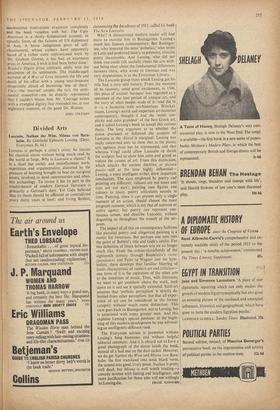Di vided Arts
LiissING is perhaps a critic's critic; he retains his classical status without being much read by the world at large. Why is Laocoon a classic? It is a short but untidy and miscellaneous work, repetitious and argumentative, distorted by the pressure of learning brought to bear on marginal Issues, involved in dead controversies and obso- lete archaeology. To revere it for its part in the establishment of modern German literature is primarily a German's duty. Yet Gide believed that its thesis should be affirmed or contradicted every thirty years at least; and Irving Babbitt, denouncing the decadence of 1911, called his book The New Laocoon.
Why? A disinterested modern reader will find more to exercise him in Baumgarten. Lessing's much less famous contemporary. But Baumgar- ten, who invented the term `aesthetics; who wrote in Latin and preferred theory to polemics, remains pretty inaccessible. And Lessing, who did not think you could talk usefully about the arts with- out being clear about the fundamental differences between them, who wrote in German and was very disputatious, is in the Everyman Library.
The Laocoon group from which Lessing got his title had a very odd history. From the moment of its recovery, amid great excitement, in 1506, this piece of ancient 'baroque' was regarded as a specimen of the best period of antique art, and the story of what people made of it—and did to it—is a favourite with art-historians. Winckel- mann, Lessing's weird and important art-historian contemporary, thought it had the 'noble sim- plicity and calm grandeur' of the best Greek art, and it suited Lessing's book to accept this curious thesis. The long argument as to whether the statue preceded or followed the account of LaocoOn in the .Eneid is marginal; Lessing was really concerned only to show that in the plastic arts ugliness must not be represented, and that whereas Virgil could allow Laocoon to shriek the sculptor had to show him calm and grand or violate the canons of art. From this distinction, which attacks the 'ancient doctrine at pie-Jura poesis—still at the time highly influential- Lessing, a most intelligent writer, drew important conclusions. The signs employed by poetry and painting are different; 'colours are not tones and eyes are not ears'; painting uses figures and colours in space, poetry articulates sounds in time. Painting, since it can present only a single moment of an action, should choose the most pregnant moment, which is not that of supreme or active agony; but poetry can represent con- tinuous action, and describe Laocoon, without disgusting us throughout the assault of the ser- pents.
The impact of all this on contemporary fashions like pictorial poetry and allegorical painting is a matter for historians. But perhaps one now sees the point of Babbitt's title and Gide's advice. For this definition of limits between arts we no longer much like. From the .colour-clavichords of the eighteenth century through Baudelaire's corre- spondances and Pater to Wagner and the Sym- bolists, there develops that familiar blurring of limits characteristic of modern art and criticism— one form of it is the aspiration of the other arts to the condition of music. Thus, with literature, we want to get somehow above the work, look down on it and see it spatially extended. Such art assumes that 'aesthetic perception' is strictly de- limited from other perception; but that all exper- ience of art can be considered in the former category without much more distinction. This view goes back to Baumgarten, not to Lessing. but is associated with many greater men. And this explains Lessing's special position; at the begin- ning of this modern development he was advocat- ing an intelligently different road.
The Everyman edition, is presented without Lessing's long footnotes and without helpful editorial comment. And it is absurd not to have a good photograph of the statue inside the book, instead of a bad one on the dust-jacket. However, we do get Nathan the Wise and Minna von Barn- helm, the first translated into weak blank verse, the second into good, lively prose. Nathan is pretty well dead, but Minna is well worth reading—a comedy written with feeling and intelligence, and more justification for those who will not willingly






































 Previous page
Previous page